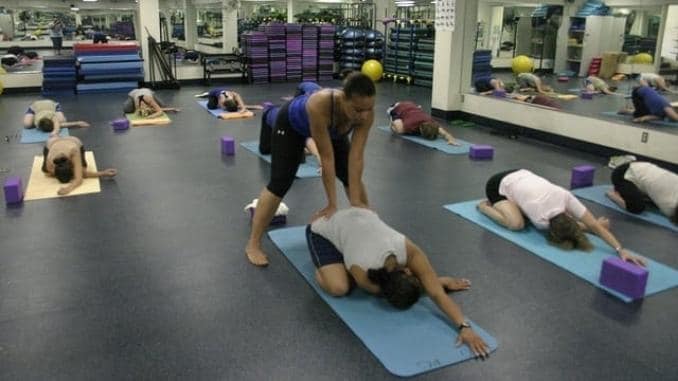
Happy International Day of Yoga!
I am coming to you from San Diego and am just on my way home. If you plan to celebrate the day, I have a few tips for you to stay injury-free when doing yoga.
Yoga can be quite appealing, with its seemingly gentle movements and sense of serenity. It is seen as a calm activity. While some sports or exercise routines are classified as high-impact, yoga, on the other hand, typically falls into the opposite category.

Thus, there may be an appearance of safety while performing yoga. Of course, what could go wrong? Surely, it must be safe and injury-free? Right?
Well… as difficult as it may be to believe, a person can get injured while performing yoga, and you don’t want to be that person!
So, what can you do? Can you truly stay injury free while performing yoga? Luckily, the answer is YES!
It should also be noted that injury during yoga sessions may not be felt immediately during or after the session, but this does not eliminate the fact that injury may have occurred [1]. Yes, it’s good to emphasize this… it can be safe to do yoga. However, the key to safety is knowing how to stay free from injury!
Many people continue to do yoga despite experiencing an injury. For example, a study involving 23,393 adults in the United States to determine if yoga practitioners discontinued yoga after the injury occurred determined that the injuries sustained were an infrequent barrier to continued yoga practice [2].
Understandably, a person who suffers an injury during yoga may be careful to avoid such an injury. If you want to stay injury-free, you can take steps to help prevent injury as you engage in yoga movements.
The following six tips outline some ways to remain injury-free while performing yoga:
1. Understand that injuries can happen.
Some people say that we do better when we know better! There is truth in this. Sometimes, simple awareness is just the ticket we need to keep us on the path to safety.
Care must be taken to ensure that people, especially trainers, are well trained and realize that injuries happen if precautions are not taken. Information is power, and simply understanding that activities like yoga can cause injuries helps prepare our mindset. Yoga trainers must also understand that people can get injured while doing yoga.
2. Know your limits.
Things go wrong sometimes, and yes, on some occasions, this happens because a person does not know their limits. Even worse, some people do know their limits but decide to push them. This happens for various reasons, including trying to do better than everyone else or showing off movements that should only be attempted when the body has been prepared or conditioned to handle such feats. Ego can be a HUGE problem here as well.
Do your best to maintain limits that your body is comfortable with. If you’re new to yoga and joining a class, seek a class for beginners. Please beware of the ego because it could turn your yoga experience into a nightmare.
3. Don’t overdo it.
If you have been doing yoga for a while, you probably have a couple of movements that you can easily accomplish. Although your muscles may be able to respond and flex as needed easily, it is possible to overuse these muscles! Yes, beware!! You can wear out your muscles during yoga, and then guess what… injury and pain may result. Watch those muscles! Go slow. Do not overwork those ligaments.
In addition, it’s beneficial to note that some yoga positions place the body in unnatural postures [3]. Attempting such postures or staying in such postures for extended periods could wreak havoc on the body.
4. Use the right technique.
Posture can be everything when performing yoga movements. Sometimes, certain movements or incorrect yoga techniques put pressure on the body and cause injury. Including a slight bend in the knees could mean the difference between lower back pain and a pain-free yoga session.
CLICK HERE to watch the YouTube video.
Some yoga movements require your back to be straight rather than bent or curved; this straight-back posture can help keep your core stable. Moving your hips during certain movements can also help relieve tension, provide a cushion, and prevent muscle tears. Deep forward bends are also a common cause of pain in the back. Hence, use the right technique. Breathing properly while doing yoga is also an important aspect to consider.
5. Use props.
Props can assist in yoga movements that are too strenuous to do. Props can also provide a way to ease into a movement that may be too risky to try without adequate support. There are times when using props can become necessary while doing yoga.
Using props can gradually and safely enable the muscles to gain strength and flexibility as you attempt yoga moves. Eventually, your muscles may remember the movements and perform these movements with ease. This is a great way to continue to advance with skill and technique without presenting the body with unnecessary risk and injury. Using a yoga mat can provide some support. A rolled towel could also relieve some pressure and prevent strains.
6. Know the common injuries.
Knowing the injuries that commonly occur during yoga sessions may have a better chance of avoiding such injuries. These common yoga injuries include hamstring pulls, lower back pain, neck injuries, knee tears, and wrist strains. Being in contact with the ground continuously and using the wrists for support can wear out the wrist ligaments and tissues. Distributing your weight can also help ensure that the neck and other regions of the body are secure.
In a case study regarding yoga-related injuries in Canada from 1991 to 2010, data were collected from 48 females and 18 males with a median age of 19. The most common injury reported was a sprain (34% of the injuries), while the most common injured body region was the lower extremity (42% of the injuries) [4]. These injuries do happen. Awareness and prevention are important.
Yoga can be great for you!
Losing pounds could be a benefit of yoga, too, and doing 30 minutes of yoga a week can provide great results on the scale [5].
Besides remaining healthy and injury-free, imagine being able to tone your body and be in great shape! Who knew that yoga could be so rewarding? Also, research has shown that practicing yoga regularly may contribute to a positive and healthy lifestyle [6].
While yoga can energize a person, calm moods, strengthen muscles and improve agility, there are instances where people can get injured. So, embrace the information presented and be determined to avoid injuries while enjoying the great benefits of yoga. Tame the ego and seek the possibility of remaining injury-free while performing yoga. Great!! While injuries during yoga can happen, remaining injury-free is within your reach.
Now that you are on your way to remaining injury-free, you can join millions worldwide and celebrate the International Day of Yoga!
If you want more information on Yoga and Injuries, then check out these articles:
- https://exercisesforinjuries.com/how-to-go-back-to-yoga-after-a-back-injury/
- https://exercisesforinjuries.com/what-if-yoga-stretches-are-too-hard-for-your-shoulder/
- https://exercisesforinjuries.com/yoga-and-injuries-with-kris-fondran/
Rick Kaselj, MS
P.S. – Happy Father’s Day to all you dads out there.
For your yoga guide to increased energy, check out the 12 Yoga Poses to Wake Up Energized and Start Your Day Off Feeling Fresh here!



